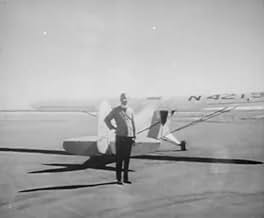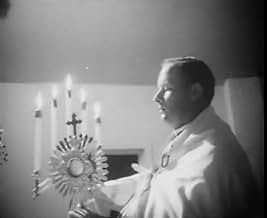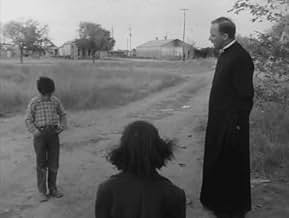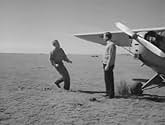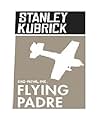Füge eine Handlung in deiner Sprache hinzuTwo days in the life of priest Father Fred Stadtmuller whose New Mexico parish is so large he can only spread goodness and light among his flock with the aid of a monoplane. The priestly pil... Alles lesenTwo days in the life of priest Father Fred Stadtmuller whose New Mexico parish is so large he can only spread goodness and light among his flock with the aid of a monoplane. The priestly pilot is seen dashing from one province to the next at the helm of his trusty Piper Cub admin... Alles lesenTwo days in the life of priest Father Fred Stadtmuller whose New Mexico parish is so large he can only spread goodness and light among his flock with the aid of a monoplane. The priestly pilot is seen dashing from one province to the next at the helm of his trusty Piper Cub administering guidance (his plane, the Flying Padre) to unruly children, sermonizing at funeral... Alles lesen
- Regie
- Drehbuch
- Hauptbesetzung
Empfohlene Bewertungen
It follows two days in the life of priest Father Fred Stadtmuller whose New Mexico parish is so large he can only spread goodness and light among his flock with the aid of a mono-plane. The priestly pilot is seen dashing from one province to the next at the helm of his trusty Piper Club administering guidance to unruly children, sermonizing at funerals and flying a sickly child and its mother to hospital.
In the light of Kubrick's later deeply ironic works, one is tempted to view these events in a slightly sinister, mischievous light. However its ironic sense can only be derived from its ludicrous, super-earnest newsreel format - commonplace at the time. Kubrick was to put such a format to good, unsettling use with the voice-over introduction to Dr Strangelove, Alex's voice-over in Clockwork Orange, Michael Horden's instructing tones in Barry Lyndon, and Private Joker's darkly humorous commentary in Full Metal Jacket. With this film, no such irony was intended (I think).
This is a strictly by-the book programmer; a second feature documentary made by a twenty-three year old future maestro for money, experience, and industry kudos. There are no real signs of Kubrick's later talent for pictorial composition (even though he was at this point a noted photo-journalist) or razor sharp narrative intellect. Although it is a perfectly competent piece, Flying Padre is virtually indistinguishable in form and content from any other programmer of the period.
Yet it is Kubrick and as such it's a valuable document in the early development of one of film's greatest artists. But for a real hint of what was to come, one should look at Kubrick's Day of the Fight made a year earlier. Invention, control of form, photographic dazzle, and energy. It's all there... except the irony. That was to arrive with Fear and Desire (1953).
'Flying Padre' is a cheery nine-minute documentary detailing the kind-hearted exploits of a priest in an isolated country region. Equipped with his $2000, single-motor plane, The Spirit of St. Joseph, this "flying padre" is able to spread his compassion and goodwill across a 1200 mile expanse, never asking anything in return for his unwavering commitment to society. The film follows the priest across two "ordinary days," as he attends to such diverse errands as a country funeral, a child bully, a sick baby and looking after his flock of breeding canaries.
If it hadn't been for a tiny director credit at the beginning of the film, I would never have guessed that Kubrick was involved in any way. The acting is quite poor and, despite the narrator's assurances that all these adventures are happening spontaneously, it's obvious that most of the shots have been pre-planned. How, otherwise, can they explain that the cameraman reached the house of the sick baby long before the padre ever did?! On a side note, however, I did enjoy the very final shot of the film, as the ambulance carrying the sick baby accelerates away from the priest standing beside his plane. From the retreating car's point of view, we watch as the humble padre and his beloved Spirit of St. Joseph diminish into the distance.
This is only for curiosity value, being made by Kubrick it has none of his mark on it. Its just for getting a foot in the industry I guess, or money. Situations are clearly staged and not so very well done, the voice-over is one sided and the shooting is diverse, but serves no special purpose. Kubrick the perfectionist turned up later I guess.
It's really hard to find any Kubrick's later trademarks here, in fact it's nearly impossible even recognize it's directed by him if you don't know it already nor catch his name in the opening credits. I really wouldn't recommend this except for its curiosity values.
We follow a flying padre doing stuff most fathers (the religious type) do. The only special thing here is the fact that this man travels by plane since the area he is connected to is pretty big. Not that special I guess. Even the technique and ways of telling a story Kubrick used in later and even earlier work is not there.
Told very straight forward, it is eight minutes from a master doing a not very masterful thing. Interesting in a way, worth watching since it only takes eight minutes of your time.
Wusstest du schon
- WissenswertesProduction #14208.
- Crazy CreditsThe narrator identifies Father Stadmueller.
- VerbindungenFeatured in The Art of Stanley Kubrick: From Short Films to Strangelove (2000)
Top-Auswahl
Details
- Erscheinungsdatum
- Herkunftsland
- Sprache
- Auch bekannt als
- Screenliners (1950-1951 season) #8: Flying Padre
- Drehorte
- Produktionsfirma
- Weitere beteiligte Unternehmen bei IMDbPro anzeigen
- Laufzeit
- 9 Min.
- Farbe
- Seitenverhältnis
- 1.37 : 1

